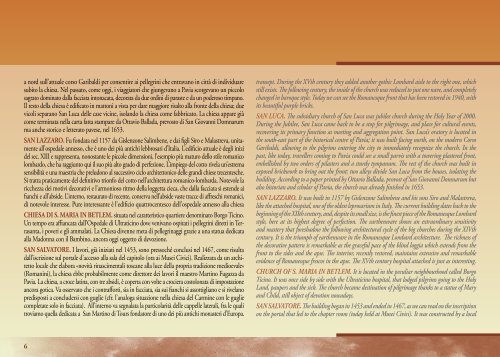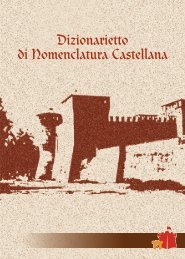luoghi e percorsi tra arte e fede nelle - Provincia di Cremona
luoghi e percorsi tra arte e fede nelle - Provincia di Cremona
luoghi e percorsi tra arte e fede nelle - Provincia di Cremona
Create successful ePaper yourself
Turn your PDF publications into a flip-book with our unique Google optimized e-Paper software.
a nord sull’attuale corso Garibal<strong>di</strong> per consentire ai pellegrini che en<strong>tra</strong>vano in città <strong>di</strong> in<strong>di</strong>viduare<br />
subito la chiesa. Nel passato, come oggi, i viaggiatori che giungevano a Pavia scorgevano un piccolo<br />
sagrato dominato dalla facciata intonacata, decorata da due or<strong>di</strong>ni <strong>di</strong> paraste e da un poderoso timpano.<br />
Il resto della chiesa è e<strong>di</strong>ficato in mattoni a vista per dare maggiore risalto alla fronte della chiesa; due<br />
vicoli separano San Luca delle case vicine, isolando la chiesa come fabbricato. La chiesa appare già<br />
come terminata nella carta fatta stampare da Ottavio Ballada, prevosto <strong>di</strong> San Giovanni Domnarum<br />
ma anche storico e letterato pavese, nel 1653.<br />
san lazzaro. Fu fondata nel 1157 da Gislenzone Salimbene, e dai figli Siro e Malastreva, unitamente<br />
all’ospedale annesso, che è uno dei più antichi lebbrosari d’Italia. L’e<strong>di</strong>ficio attuale è degli inizi<br />
del sec. XIII e rappresenta, nonostante le piccole <strong>di</strong>mensioni, l’esempio più maturo dello stile romanico<br />
lombardo, che ha raggiunto qui il suo più alto grado <strong>di</strong> perfezione. L’impiego del cotto rivela un’estrema<br />
sensibilità e una maestria che preludono al successivo ciclo architettonico delle gran<strong>di</strong> chiese trecentesche.<br />
Si <strong>tra</strong>tta praticamente del definitivo trionfo del cotto nell’architettura romanico-lombarda. Notevole la<br />
ricchezza dei motivi decorativi e l’armonioso ritmo della loggetta cieca, che dalla facciata si estende ai<br />
fianchi e all’abside. L’interno, restaurato <strong>di</strong> recente, conserva nell’abside vaste <strong>tra</strong>cce <strong>di</strong> affreschi romanici,<br />
<strong>di</strong> notevole interesse. Pure interessante è l’e<strong>di</strong>ficio quattrocentesco dell’ospedale annesso alla chiesa<br />
chiesa <strong>di</strong> s. Maria in BetleM. situata nel caratteristico quartiere denominato Borgo Ticino.<br />
Un tempo era affiancata dall’Ospedale <strong>di</strong> Ul<strong>tra</strong>ticino dove venivano ospitati i pellegrini <strong>di</strong>retti in Terrasanta,<br />
i poveri e gli ammalati. La Chiesa <strong>di</strong>venne meta <strong>di</strong> pellegrinaggi grazie a una statua de<strong>di</strong>cata<br />
alla Madonna con il Bambino, ancora oggi oggetto <strong>di</strong> devozione.<br />
san salvatore. I lavori, già iniziati nel 1453, sono pressoché conclusi nel 1467, come risulta<br />
dall’iscrizione sul portale d’accesso alla sala del capitolo (ora ai Musei Civici). Realizzata da un architetto<br />
locale che elabora «novità rinascimentali toscane alla luce della propria <strong>tra</strong><strong>di</strong>zione me<strong>di</strong>oevale»<br />
(Romanini), la chiesa ebbe probabilmente come <strong>di</strong>rettore dei lavori il maestro Martino Fugazza da<br />
Pavia. La chiesa, a croce latina, con tre absi<strong>di</strong>, è coperta con volte a crociera costolonata <strong>di</strong> impostazione<br />
ancora gotica. Va osservato che i con<strong>tra</strong>fforti, sia in facciata, sia sui fianchi si assottigliano e si rivelano<br />
pre<strong>di</strong>sposti a concludersi con guglie (cfr. l’analoga situazione nella chiesa del Carmine con le guglie<br />
completate solo in facciata). All’interno va segnalata la particolarità delle cappelle laterali, fra le quali<br />
troviamo quella de<strong>di</strong>cata a San Martino <strong>di</strong> Tours fondatore <strong>di</strong> uno dei più antichi monasteri d’Europa.<br />
<strong>tra</strong>nsept. During the XVth century they added another gothic Lombard aisle to the right one, which<br />
still exists. The following century, the inside of the church was reduced to just one nave, and completely<br />
changed in baroque style. Today we can see the Romanesque front that has been restored in 1940, with<br />
its beautiful purple bricks.<br />
san LuCa. The subsi<strong>di</strong>ary church of San Luca was jubilee church during the Holy Year of 2000.<br />
During the Jubilee, San Luca came back to be a stop for pilgrimage, and place for cultural events,<br />
recovering its primary function as meeting and aggregation point. San Luca’s oratory is located in<br />
the south-east part of the historical centre of Pavia; it was built facing north, on the modern Corso<br />
Garibal<strong>di</strong>, allowing to the pilgrims entering the city to imme<strong>di</strong>ately recognize the church. In the<br />
past, like today, <strong>tra</strong>vellers coming to Pavia could see a small parvis with a towering plastered front,<br />
embellished by two orders of pilasters and a sturdy tympanum. The rest of the church was built in<br />
exposed brickwork to bring out the front; two alleys <strong>di</strong>vide San Luca from the houses, isolating the<br />
buil<strong>di</strong>ng. Accor<strong>di</strong>ng to a paper printed by Ottavio Ballada, provost of San Giovanni Domnarum but<br />
also historian and scholar of Pavia, the church was already finished in 1653.<br />
san Lazzaro. It was built in 1157 by Gislenzone Salimbene and his sons Siro and Malastreva,<br />
like the attached hospital, one of the oldest leprosarium in Italy. The current buil<strong>di</strong>ng dates back to the<br />
beginning of the XIIth century, and, despite its small size, is the finest piece of the Romanesque Lombard<br />
style, here at its highest degree of perfection. The earthenware shows an ex<strong>tra</strong>or<strong>di</strong>nary sensitivity<br />
and mastery that foreshadow the following architectural cycle of the big churches during the XIVth<br />
century. It is the triumph of earthenware in the Romanesque Lombard architecture. The richness of<br />
the decorative pattern is remarkable as the graceful pace of the blind loggia which extends from the<br />
front to the sides and the apse. The interior, recently restored, maintains extensive and remarkable<br />
evidence of Romanesque frescos in the apse. The XVth century hospital attached is just as interesting.<br />
ChurCh of s. Maria in BetLeM. It is located in the peculiar neighbourhood called Borgo<br />
Ticino. It was once side by side with the Ul<strong>tra</strong>ticino hospital, that lodged pilgrims going to the Holy<br />
Land, paupers and the sick. The church became destination of pilgrimage thanks to a statue of Mary<br />
and Child, still object of devotion nowadays.<br />
san saLvatore. The buil<strong>di</strong>ng began in 1453 and ended in 1467, as we can read on the inscription<br />
on the portal that led to the chapter room (today held at Musei Civici). It was constructed by a local<br />
Il suo culto è particolarmente vivo presso i Benedettini; lo stesso San<br />
Benedetto gli aveva intitolato la chiesa <strong>di</strong> Montecassino. Nato nel 316<br />
o 317 in Pannonia, Martino <strong>tra</strong>scorre la giovinezza a Pavia dove riceve<br />
una preparazione <strong>di</strong> tipo umanistico e conosce il cristianesimo. Avviato<br />
alla carriera militare, durante una ronda d’ispezione notturna si imbatte<br />
in un povero seminudo a cui dona metà del suo mantello. Si <strong>tra</strong>tta del<br />
fatto più noto della sua vita, avvenuto presso Amiens nel 338.<br />
Belgioioso, oratorio<br />
<strong>di</strong> san Giacomo della cerreta<br />
chiesa <strong>di</strong> san lanFranco. Una primitiva chiesa de<strong>di</strong>cata al Santo Sepolcro era ubicata in<br />
località «costa Fragonaria» nei pressi del piccolo centro <strong>di</strong> Santa Sofia, ad ovest della città. Il Funus<br />
monasticum, un antico rituale app<strong>arte</strong>nuto al monastero <strong>di</strong> San Lanfranco riporta come data <strong>di</strong><br />
fondazione il 1090. Solo più tar<strong>di</strong> però si riscon<strong>tra</strong> la presenza vallombrosana ufficialmente strutturata<br />
in un cenobio isolato, ma più prossimo alla città, immerso nei boschi della Valvernasca. Nel<br />
1145 i vallombrosani risultano ormai stabiliti nella nuova e definitiva collocazione. All’interno una<br />
pregevole arca dell’Amadeo de<strong>di</strong>cata a San Lanfranco, illus<strong>tra</strong> la vita del Santo che fu Vescovo <strong>di</strong> Pavia.<br />
BelGioioso. Il paese si trova sull’antico precorso della Via Francigena e proprio lungo questo<br />
itinerario sorge l’oratorio <strong>di</strong> San Giacomo della Cerreta. L’e<strong>di</strong>ficio <strong>di</strong> forme quattrocentesche, con una<br />
graziosa e ricca decorazione <strong>di</strong> terracotta e un curioso campaniletto cilindrico nella p<strong>arte</strong> posteriore<br />
è abbellito da numerosi affreschi. Un tempo vi era anche l’ospedale in cui i pellegrini <strong>di</strong>retti a Roma<br />
facevano tappa per riposarsi e rifocillarsi, purtroppo non sono rimaste <strong>tra</strong>cce dell’antico e<strong>di</strong>ficio.<br />
trivolzio. La Chiesa Parrocchiale de<strong>di</strong>cata ai santi martiri Cornelio e Cipriano è considerata<br />
luogo <strong>di</strong> grande devozione in quanto conserva le spoglie <strong>di</strong> San Riccardo Pampuri, me<strong>di</strong>co e religioso<br />
dell’Or<strong>di</strong>ne dei Fatebenefratelli morto a soli 33 anni e proclamato santo nel 1989 da Giovanni Paolo<br />
II. Un santo giovane che ha saputo coinvolgere, per la sua normalità i giovani, assidui frequentatori del<br />
Santuario e che contribuiscono attivamente a far conoscere la figura <strong>di</strong> San Riccardo nel mondo.<br />
certosa <strong>di</strong> Pavia. Monumento celebrato e famoso nel mondo è un vero e proprio gioiello<br />
d’<strong>arte</strong>. E<strong>di</strong>ficato nel 1396 per volere <strong>di</strong> Gian Galeazzo Visconti come mausoleo <strong>di</strong> famiglia, è una<br />
reale testimonianza <strong>di</strong> come stili <strong>di</strong>versi che vanno dal gotico lombardo, al rinascimentale, al barocco,<br />
possano dare origine a un complesso così armonioso. Alla sua costruzione, durata due secoli, p<strong>arte</strong>ciparono<br />
artisti e architetti <strong>di</strong> grande fama come Bernardo da Venezia, Cristoforo da Conigo, Giovanni e<br />
architect that elaborated “Tuscan Renaissance innovations in the light<br />
of his me<strong>di</strong>eval <strong>tra</strong><strong>di</strong>tion” (Romanini), and probably Master Martino<br />
Fugazza da Pavia was in charge of the buil<strong>di</strong>ng. The church, a Latin<br />
cross plan, with three apses, is covered with a ribbed vault, which is still<br />
a gothic structure. We must notice that the counterforts, in the front<br />
and at the sides, get thinner and are pre<strong>di</strong>sposed to end with steeples<br />
(compare them with the similar situation of the Church Del Carmine,<br />
with steeples only on the front). On the inside take notice of the peculiarity of the chapels on the sides,<br />
among them the one de<strong>di</strong>cated to San Martino from Tours, founder of one of the oldest monastery in<br />
Europe. Bene<strong>di</strong>ctines monks are especially keen to worship him: San Benedetto himself de<strong>di</strong>cated him<br />
the church at Montecassino. Born in 316 or 317 in Pannonia, Martino spent his youth in Pavia,<br />
where he received a liberal education and learnt about Christianity. Groomed for a military career,<br />
one night, during a patrol he met a naked pauper and he gave him half of his cloak. This is the most<br />
famous episode of his life and took place in Amiens in 338.<br />
ChurCh of san LanfranCo. A primitive church de<strong>di</strong>cated to the Empty Tomb<br />
was in “costa Fragonaria”, next to the small town of Santa Sofia, west of the city. The Funus<br />
monasticum, an old ritual belonged to the monastery of San Lanfranco, quotes 1090 as the year<br />
of foundation. But it is only later that we can find <strong>tra</strong>ces of Vallombrosian presence officially<br />
structured in an isolated cenoby, but closer to the city, among the woods of Valvernasca. In 1145<br />
Vallombrosians are already settled in their new location. Inside, a remarkable sarcophagus of<br />
Amadeo, de<strong>di</strong>cated to San Lanfranco, depicts the life of the Saint that was Bishop of Pavia.<br />
BeLGioioso. The town is on the old <strong>tra</strong>il of the via Francigena, and along this road stands the<br />
oratory of San Giacomo della Cerreta. The XVth century buil<strong>di</strong>ng, with a graceful and abundant<br />
earthenware embellishment and a peculiar cylindrical bell tower, has many frescos in the back. In<br />
the past there was also a hospital where pilgrims going to Rome could stop and take a rest and have<br />
something to eat, unfortunately there are no remains of this old buil<strong>di</strong>ng.<br />
trivoLzio. The parish church de<strong>di</strong>cated to the Saints and martyrs Cornelio and Cipriano is<br />
an important place of worship because it retains the remains of San Riccardo Pampuri, doctor and<br />
religious of the Brothers Hospitallers of St. John of God, he <strong>di</strong>ed at the young age of 33 and was<br />
6 7



